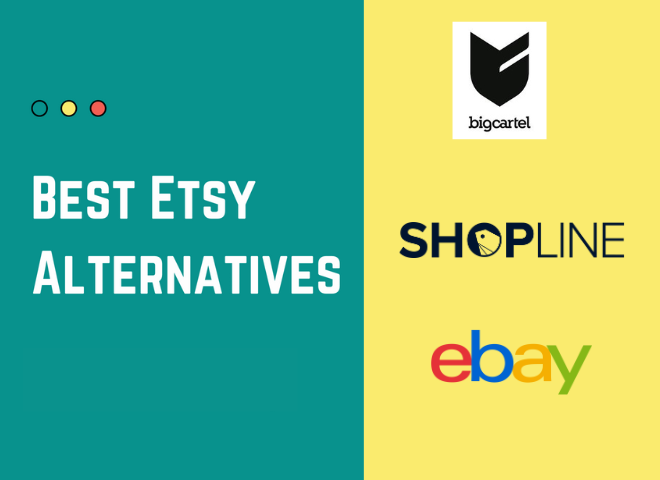Before embarking on the journey of creating your own online marketplace, it's essential to delve into the success factors that have propelled Etsy to its prominent position. Etsy, founded in 2005, has become synonymous with a vibrant community of artisans, craftsmen, and unique vintage finds. Here's a closer look at the key aspects that contribute to the Etsy model:
- Niche Focus: Etsy carved its niche by focusing on handmade, vintage, and unique products. This niche positioning creates a distinct identity and attracts a specific audience passionate about one-of-a-kind items.
- Community-Centric Approach: Central to Etsy's success is the emphasis on building a strong community. Sellers and buyers interact through forums, reviews, and collaborative projects, fostering a sense of connection and trust.
- Easy Listing and Transaction Process: Etsy simplifies the process for sellers to list their products, making it accessible for small businesses and individual creators. The streamlined transaction process also contributes to a positive user experience.
- Search and Discovery Features: Etsy's robust search and discovery algorithms help users find products tailored to their preferences. This enhances user engagement and encourages repeat visits to the platform.
- Mobile-Friendly Design: Recognizing the importance of mobile users, Etsy ensures a seamless experience across devices. A mobile-friendly design expands the reach of the marketplace and accommodates the preferences of modern shoppers.
Etsy's success is not just about selling products; it's about creating a vibrant ecosystem where creativity thrives, and connections flourish. While building your marketplace, consider incorporating these elements to resonate with your target audience. Additionally, understanding how Etsy maintains a delicate balance between commerce and community will guide you in shaping the culture of your own platform.
Now, let's take a closer look at a table summarizing some key features of the Etsy model:
| Aspect | Description |
|---|---|
| Niche Focus | Handmade, vintage, and unique products. |
| Community-Centric Approach | Emphasis on building a strong and engaged community of sellers and buyers. |
| Easy Listing and Transaction Process | Simplified processes for sellers to list products and conduct transactions. |
| Search and Discovery Features | Robust algorithms for personalized product discovery. |
| Mobile-Friendly Design | Ensures a seamless experience across devices to cater to the modern user. |
Essential Features for Your Marketplace

As you embark on the exciting journey of creating your own online marketplace, it's crucial to identify and implement essential features that will set the foundation for a successful platform. These features not only enhance the user experience but also contribute to the overall functionality and appeal of your marketplace. Let's explore some key elements that you should consider integrating into your platform:
- User-Friendly Interface: Design a clean and intuitive interface that allows both sellers and buyers to navigate effortlessly. A user-friendly interface enhances engagement and encourages users to explore more.
- Secure Payment Gateway: Implement a secure and reliable payment gateway to facilitate smooth transactions. Security is paramount to gaining the trust of your users and ensuring the success of your marketplace.
- Product Search and Filters: Enhance the discoverability of products by incorporating robust search and filtering options. Users should be able to easily find products based on categories, prices, and other relevant criteria.
- Product Listings and Descriptions: Provide sellers with easy-to-use tools for creating appealing product listings. Encourage detailed product descriptions, high-quality images, and relevant tags to improve visibility.
- Rating and Review System: Foster a transparent and trustworthy environment by including a rating and review system. This allows buyers to make informed decisions and builds credibility for sellers.
- Mobile Responsiveness: Ensure that your marketplace is accessible on various devices, especially mobile phones. A mobile-responsive design caters to the preferences of users who prefer shopping on the go.
- Inventory Management: Provide sellers with tools to efficiently manage their inventory, including tracking stock levels, managing variations, and receiving low stock notifications.
Now, let's take a closer look at a table summarizing these essential features:
| Feature | Description |
|---|---|
| User-Friendly Interface | Design a clean and intuitive interface for seamless navigation. |
| Secure Payment Gateway | Implement a secure and reliable payment gateway for smooth transactions. |
| Product Search and Filters | Enhance product discoverability with robust search and filtering options. |
| Product Listings and Descriptions | Provide sellers with tools for creating appealing listings with detailed descriptions and images. |
| Rating and Review System | Include a transparent rating and review system to build trust and credibility. |
| Mobile Responsiveness | Ensure the platform is accessible on various devices, especially mobile phones. |
| Inventory Management | Provide tools for sellers to efficiently manage their inventory. |
Also Read This: Discovering the Best States for Technology Jobs Across the USA
Design and User Experience
Creating an enticing and user-friendly design is paramount for the success of your online marketplace. The design and user experience (UX) of your platform play a crucial role in attracting and retaining users. Let's delve into key considerations and strategies to ensure an aesthetically pleasing and seamless user experience:
- Intuitive Navigation: Design a clear and intuitive navigation system that allows users to easily explore different sections of your marketplace. Logical categorization and well-organized menus contribute to a positive user experience.
- Appealing Visuals: Use high-quality images and engaging visuals to showcase products. A visually appealing marketplace captures the attention of users and encourages them to explore further.
- Consistent Branding: Maintain a consistent and cohesive branding throughout your platform. Consistency in color schemes, fonts, and overall design elements helps in building brand recognition and trust among users.
- Responsive Design: Ensure your marketplace is responsive across various devices, including desktops, tablets, and smartphones. A responsive design adapts to different screen sizes, providing a seamless experience for users on any device.
- Streamlined Checkout Process: Simplify the checkout process to minimize friction for buyers. A one-click checkout option, clear calls-to-action, and progress indicators contribute to a smooth transaction experience.
- Personalization Features: Implement personalization features that cater to individual user preferences. This could include personalized recommendations, saved favorites, and a tailored user dashboard.
- User Feedback Integration: Actively seek and incorporate user feedback to continuously improve the design and user experience. This ensures that your platform evolves based on the needs and expectations of your user base.
Now, let's take a closer look at a table summarizing the design and user experience considerations:
| Consideration | Description |
|---|---|
| Intuitive Navigation | Design a clear and intuitive navigation system for easy exploration. |
| Appealing Visuals | Use high-quality images and engaging visuals to showcase products. |
| Consistent Branding | Maintain a consistent and cohesive branding throughout the platform. |
| Responsive Design | Ensure the marketplace is responsive across various devices. |
| Streamlined Checkout Process | Simplify the checkout process to minimize friction for buyers. |
| Personalization Features | Implement features that cater to individual user preferences. |
| User Feedback Integration | Actively seek and incorporate user feedback for continuous improvement. |
Also Read This: Copyright Compliance: Navigating Copyright Infringement on Etsy
Building a Strong Community
One of the key factors that set successful marketplaces apart is the strength of their community. Building a vibrant and engaged community around your platform is not only beneficial for user satisfaction but also contributes to the long-term success of your marketplace. Let's explore strategies to foster a strong sense of community among your users:
- Interactive Forums and Discussions: Create dedicated forums or discussion boards where users, both sellers and buyers, can interact, share insights, and build connections. Encourage discussions about products, trends, and the overall marketplace experience.
- Collaborative Projects and Events: Foster collaboration by organizing community-driven projects or events. This could include themed contests, collaborative product launches, or virtual meetups. Such initiatives strengthen the bonds within the community.
- Reward Programs: Implement reward programs that recognize and appreciate active community members. This could involve badges, exclusive discounts, or other incentives to encourage participation and contribution to the community.
- Social Media Integration: Leverage social media platforms to extend the reach of your community. Create official social media accounts for your marketplace, and encourage users to share their experiences, products, and stories using dedicated hashtags.
- Featured Seller Spotlights: Highlight the stories and products of standout sellers within your community. This not only promotes individual success but also inspires others and adds a personal touch to your marketplace.
- Transparent Communication: Maintain transparent communication with your community. Keep users informed about updates, policy changes, and upcoming events. Transparency builds trust and fosters a sense of belonging among users.
- Feedback Channels: Provide easily accessible channels for users to provide feedback and suggestions. Actively listen to user input and demonstrate that their opinions are valued in shaping the direction of the marketplace.
Now, let's take a closer look at a table summarizing the strategies for building a strong community:
| Strategy | Description |
|---|---|
| Interactive Forums and Discussions | Create dedicated spaces for users to interact and share insights. |
| Collaborative Projects and Events | Foster collaboration through community-driven projects or events. |
| Reward Programs | Implement programs that recognize and appreciate active community members. |
| Social Media Integration | Leverage social media to extend the reach and engagement of the community. |
| Featured Seller Spotlights | Highlight the stories and products of standout sellers within the community. |
| Transparent Communication | Maintain open and transparent communication with the community. |
| Feedback Channels | Provide accessible channels for users to provide feedback and suggestions. |
Also Read This: Easy Methods for Image Transfer You Can Try at Home
Monetization Strategies
Monetizing your online marketplace is a crucial aspect of sustaining and growing your platform. Implementing effective monetization strategies ensures that your marketplace not only thrives but also generates revenue to support ongoing operations and future development. Let's explore diverse monetization avenues to consider for your marketplace:
- Transaction Fees: Implement a transaction fee model where a percentage of each successful transaction goes to the platform. This is a common and straightforward way to generate revenue while aligning the success of the platform with the success of the sellers.
- Subscription Plans: Introduce subscription plans for sellers, offering various tiers with different benefits. Higher-tier subscriptions can provide additional features, increased visibility, or exclusive marketing opportunities, creating a recurring revenue stream for your platform.
- Featured Listings: Allow sellers to pay for featured listings, ensuring their products appear prominently in search results or specific categories. Highlighting products can lead to increased visibility and sales for sellers, while generating revenue for the platform.
- Advertising and Sponsorships: Partner with relevant brands or businesses for advertising and sponsorships within your marketplace. Sellers can pay for sponsored product placements, and external brands can pay for banner ads or featured sections, contributing to additional revenue streams.
- Affiliate Marketing: Explore affiliate marketing by establishing partnerships with external websites or influencers. Earn a commission for every user referred to your marketplace through affiliate links, expanding your user base and generating revenue simultaneously.
- Freemium Model: Adopt a freemium model where basic features are available for free, but advanced features or premium services come with a cost. This encourages user engagement and allows sellers to choose additional features based on their needs.
- Data Insights and Analytics: Offer advanced analytics and data insights services to sellers, helping them understand market trends, customer behavior, and sales patterns. Charging a fee for access to comprehensive analytics can be a valuable monetization strategy.
Now, let's take a closer look at a table summarizing these monetization strategies:
| Strategy | Description |
|---|---|
| Transaction Fees | Implement a percentage-based transaction fee on successful transactions. |
| Subscription Plans | Introduce subscription tiers for sellers with varying benefits. |
| Featured Listings | Allow sellers to pay for featured listings to enhance product visibility. |
| Advertising and Sponsorships | Partner with brands for advertising and sponsorships within the marketplace. |
| Affiliate Marketing | Establish affiliate partnerships to earn commissions for referred users. |
| Freemium Model | Offer basic features for free and charge for advanced or premium services. |
| Data Insights and Analytics | Provide advanced analytics services to sellers for a fee. |
Also Read This: Shipping Success: Navigating Alibaba to Amazon Warehouse Shipments
Marketing Your Platform
Effective marketing plays a pivotal role in the success of your online marketplace. To ensure your platform gains visibility, attracts both sellers and buyers, and sustains growth, a well-thought-out marketing strategy is essential. Let's explore key marketing strategies to promote and elevate your platform:
- Search Engine Optimization (SEO): Optimize your platform for search engines to improve its visibility in search results. Conduct keyword research, optimize product listings, and create quality content to enhance your marketplace's SEO performance.
- Social Media Engagement: Leverage the power of social media to connect with your target audience. Create and maintain active profiles on platforms like Instagram, Facebook, and Twitter. Share engaging content, highlight products, and interact with your community to build brand awareness.
- Email Marketing Campaigns: Develop targeted email marketing campaigns to reach both sellers and buyers. Utilize newsletters, promotional offers, and personalized content to keep users informed about new features, promotions, and marketplace updates.
- Influencer Collaborations: Partner with influencers or key personalities within your niche to promote your platform. Influencers can provide authentic endorsements and reach a broader audience, driving traffic to your marketplace.
- Content Marketing: Create valuable and informative content related to your marketplace's niche. This could include blog posts, video tutorials, or infographics that not only showcase products but also establish your platform as an authoritative source within the industry.
- Referral Programs: Implement referral programs that incentivize users to refer others to your marketplace. Offering discounts, exclusive access, or other perks can encourage your existing community to actively promote your platform.
- Collaborative Marketing with Sellers: Work collaboratively with your sellers on marketing initiatives. Provide them with marketing tools, templates, and strategies to promote their products, ultimately driving traffic and sales for the entire platform.
Now, let's take a closer look at a table summarizing these marketing strategies:
| Strategy | Description |
|---|---|
| Search Engine Optimization (SEO) | Optimize the platform for search engines to improve visibility. |
| Social Media Engagement | Create active profiles on social media platforms to connect with the audience. |
| Email Marketing Campaigns | Develop targeted email campaigns to keep users informed about updates and promotions. |
| Influencer Collaborations | Partner with influencers to gain authentic endorsements and reach a broader audience. |
| Content Marketing | Create valuable content to establish your platform as an authoritative source. |
| Referral Programs | Implement programs that incentivize users to refer others to your platform. |
| Collaborative Marketing with Sellers | Work collaboratively with sellers on marketing initiatives to promote their products. |
Also Read This: Top 10 Developer Linkedin Profiles
Managing Challenges
While the journey of creating and running an online marketplace is exciting, it comes with its set of challenges. Effectively managing these challenges is crucial for the sustained success and growth of your platform. Let's explore common challenges faced by online marketplaces and strategies to overcome them:
- Trust and Security Concerns: Establish a robust trust and security infrastructure. Implement secure payment gateways, encryption measures, and transparent communication about security protocols to build trust among users.
- Competition and Saturation: Conduct thorough market research to understand your niche and competition. Differentiate your platform by offering unique features, personalized experiences, or by targeting a specific segment within the market.
- Quality Control: Implement stringent quality control measures to ensure that products listed on your platform meet certain standards. Encourage user reviews and ratings to help maintain a high level of product quality.
- Customer Support Challenges: Invest in a responsive and efficient customer support system. Provide multiple channels for customer inquiries, offer timely responses, and continuously gather feedback to improve the support experience.
- Scaling Infrastructure: Plan for scalability from the outset. Ensure that your platform's infrastructure can handle increased traffic, transactions, and data as your marketplace grows. Regularly assess and upgrade infrastructure as needed.
- Regulatory Compliance: Stay informed about and compliant with local and international regulations related to e-commerce and online marketplaces. This includes data protection laws, taxation regulations, and any industry-specific requirements.
- Seller and Buyer Retention: Develop strategies to retain both sellers and buyers. Offer loyalty programs, exclusive discounts, and personalized recommendations to encourage repeat transactions and long-term engagement.
Now, let's take a closer look at a table summarizing strategies to manage these challenges:
| Challenge | Strategies |
|---|---|
| Trust and Security Concerns | Implement secure payment gateways, encryption measures, and transparent communication about security protocols. |
| Competition and Saturation | Differentiate your platform by offering unique features, personalized experiences, or targeting a specific market segment. |
| Quality Control | Implement stringent measures to ensure product quality. Encourage user reviews and ratings. |
| Customer Support Challenges | Invest in a responsive customer support system with multiple inquiry channels and continuous feedback mechanisms. |
| Scaling Infrastructure | Plan for scalability from the outset and regularly assess and upgrade infrastructure as needed. |
| Regulatory Compliance | Stay informed and compliant with local and international e-commerce and marketplace regulations. |
| Seller and Buyer Retention | Develop retention strategies, including loyalty programs, exclusive discounts, and personalized recommendations. |
Also Read This: Knowing When an Image Is Public Domain
FAQ
Explore answers to frequently asked questions about building and managing an online marketplace:
-
- Q: How do I attract sellers to my marketplace?
A: To attract sellers, focus on creating a user-friendly interface, offering competitive transaction fees, and providing tools for effective product listings. Implement marketing strategies to showcase the benefits of selling on your platform, and consider running promotional campaigns or offering special incentives for early adopters.
-
- Q: What are the key features that buyers look for in a marketplace?
A: Buyers typically value a seamless and secure transaction process, a wide range of products, intuitive search and filtering options, and a visually appealing design. Prioritize features that enhance the overall user experience, such as transparent product reviews, personalized recommendations, and responsive customer support.
-
- Q: How can I ensure the security of transactions on my platform?
A: Ensure transaction security by implementing reputable and secure payment gateways. Encrypt sensitive data, educate users about secure practices, and regularly update your security protocols to stay ahead of potential threats. Building trust among users is crucial for the success of your marketplace.
-
- Q: What marketing strategies work best for promoting an online marketplace?
A: Effective marketing strategies include search engine optimization (SEO), social media engagement, email marketing campaigns, influencer collaborations, content marketing, referral programs, and collaborative marketing with sellers. Tailor your approach based on your target audience and industry niche.
-
- Q: How can I handle regulatory compliance for my marketplace?
A: Stay informed about local and international regulations related to e-commerce and online marketplaces. Collaborate with legal experts to ensure compliance with data protection laws, taxation regulations, and any industry-specific requirements. Regularly update your policies to align with evolving legal standards.
-
- Q: What challenges might I face in scaling my marketplace's infrastructure?
A: Scaling infrastructure challenges may include increased traffic, transaction volume, and data handling. Plan for scalability from the outset, invest in robust hosting solutions, and regularly assess your platform's performance. Consider cloud services for flexible and scalable infrastructure management.
-
- Q: How do I encourage buyer and seller retention on my platform?
A: Encourage retention by offering loyalty programs, exclusive discounts, and personalized recommendations. Provide excellent customer support, engage in collaborative marketing efforts with sellers, and continuously gather feedback to enhance user experience and satisfaction.
Conclusion
Embarking on the journey of creating a successful online marketplace requires a strategic approach, attention to detail, and a deep understanding of the dynamic e-commerce landscape. In this comprehensive guide, we've explored key aspects of building a platform that echoes the success of Etsy, covering everything from understanding the Etsy model to implementing essential features, designing a seamless user experience, and navigating challenges.
By understanding the niche focus, community-centric approach, and user-friendly features that have contributed to Etsy's success, you gain valuable insights into creating a platform that resonates with both sellers and buyers. From crafting an appealing design to fostering a strong community and implementing effective monetization and marketing strategies, each step is crucial in shaping the identity and growth of your marketplace.
Managing challenges, whether they involve trust and security, competition, or scalability, requires proactive planning and continuous adaptation. By addressing these challenges head-on and implementing robust solutions, you pave the way for long-term success.
As you move forward in your marketplace journey, remember the importance of transparent communication, user feedback, and staying compliant with regulations. Building a thriving online marketplace is an ongoing process that requires dedication, innovation, and a commitment to providing value to your community of users.
Armed with the insights and strategies outlined in this guide, you are well-equipped to navigate the complexities of the online marketplace ecosystem. Whether you're a budding entrepreneur, a seasoned developer, or someone passionate about creating a unique platform, the possibilities are vast. Now, go ahead and turn your vision into reality, and may your marketplace journey be filled with success and growth!

 admin
admin









